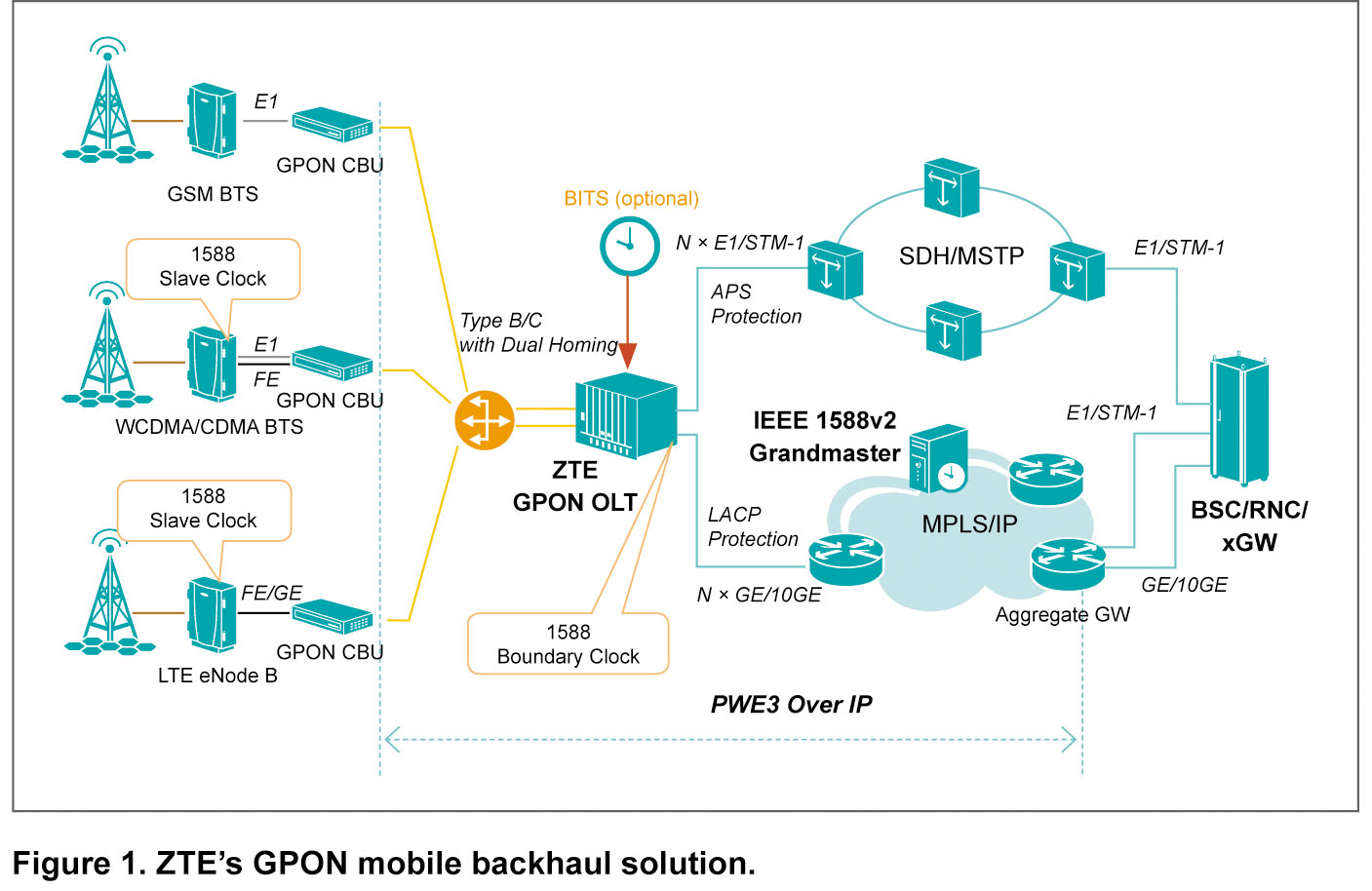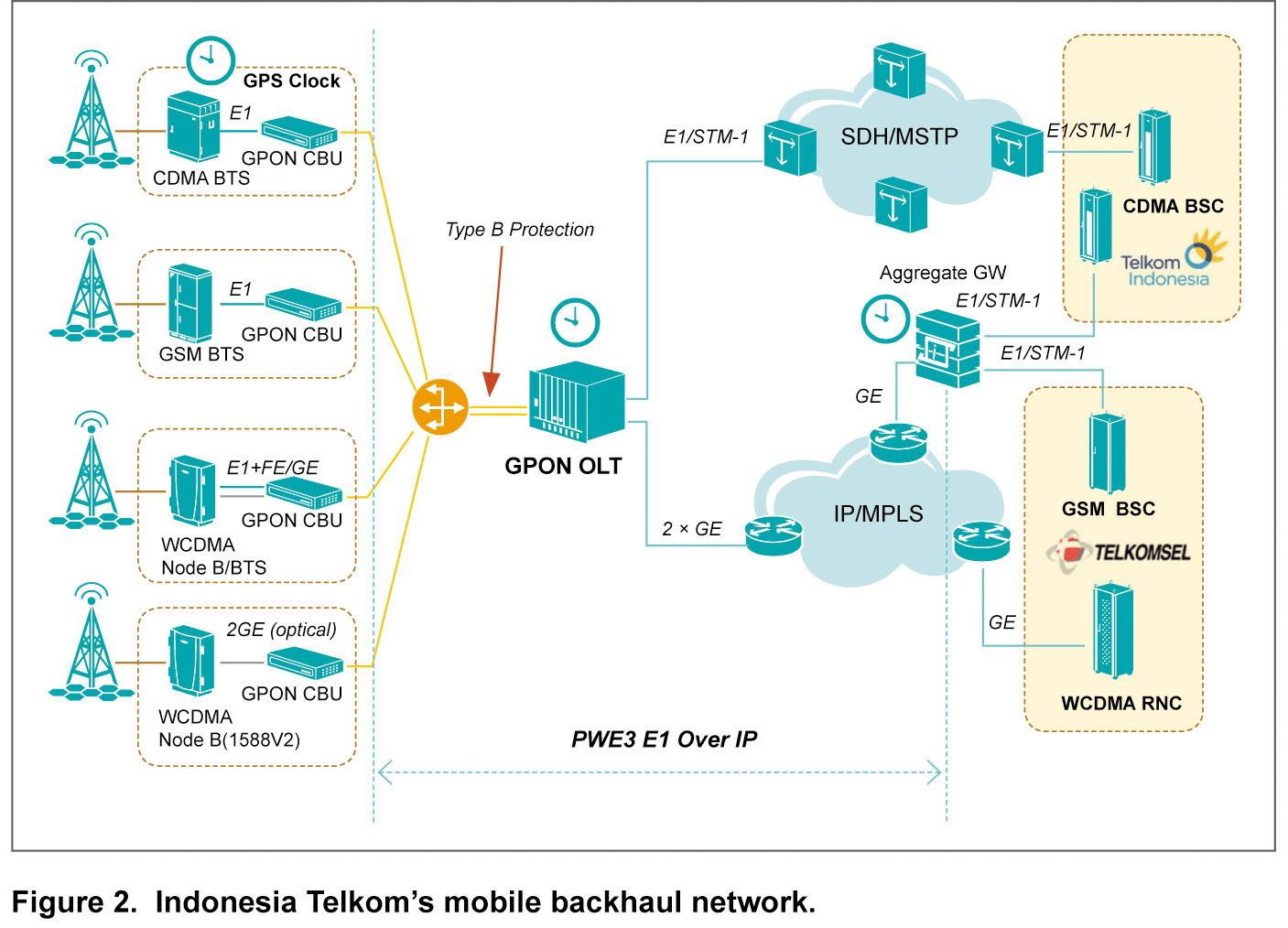GPON Mobile Backhaul Solution
Driving Force
Mobile operators must increase the capacity of their backhaul networks to accommodate the high bandwidth requirements of today’s wireless services. Although GPON is a fixed-line broadband fiber technology, its low cost and high bandwidth are advantageous for mobile backhaul connections. ZTE offers a GPON mobile backhaul solution for 2G, 3G and 4G wireless networks.
GPON Mobile Backhaul Solution
ZTE’s GPON mobile backhaul uses an advanced GPON Optical Line Terminal (OLT) and Cellular Backhaul Units (CBUs), which together can bear voice and data traffic between BTS (Node B or eNode B) and BSC (or RNC). OLT is a multiplexer that aggregates all traffic from CBUs, while CBUs are used as Optical Network Terminals (ONTs) with multiple interfaces connected to different BTSs (NodeBs or eNode Bs). A CBU supports E1, FE, or GE interfaces, and OLT provides STM-1/4, E1, or GE/10GE in the uplink for connection to SDH/MSTP and IP/MPLS bearer networks. ZTE’s GPON mobile backhaul can be combined with bearer networks, as shown in Figure 1.

Issues of clock synchronization, legacy service transmission, and service protection should be considered when building mobile backhaul networks.
Clock synchronization
For high-precision clock synchronization in base stations, ZTE’s GPON OLT can obtain clock in various ways: from built-in Stratum 3 clock, from a BITS clock synchronization network, from a SDH/MSTP network via E1/STM-1 lines, from a synchronous Ethernet (SyncE) via GE interfaces, from IEEE 1588v2 master, or from a GPS receiver.
In a GSM network, system clock should be obtained from SDH/MSTP and should be the main clock for transmission to BTS via the E1 interface. BITS clock should be a backup clock input to OLT.
For 3G and 4G networks, the system clock should be obtained from IEEE 1588v2 grandmaster and set as the main clock for transmission to Node B (or eNode B) via E1 interface (without the 1588 v2 slave) or FE interface (with the 1588v2 slave). BITS clock should be a backup clock input to OLT.
Legacy service transmission
An aggregate gateway located between BSC/RNC/xGW and MPLS/IP networks can be used to convert IP packages into E1 or STM-1. Legacy services are transmitted from CBU to the aggregation gateway using Pseudowire Emulation Edge-to-Edge (PWE3) encapsulation. Advantages of PWE3 include:
■ It is supported on both OLT and CBU, providing high reliability.
■ There are two or three E1 connections processed by CBU, which does not impact CBU processing capacity.
■ OLT supports transparent transmission of PWE3 packets, so no service slot is occupied.
■ Both Circuit Emulation Services (CES) and PWE3 are mature technologies supported by the industry standards.
■ End-to-end connectivity through a flat IP core network makes network management easier.
Service protection
Mobile backhaul requires carrier-class reliability. GPON connections for the downlink are protected using type B or type C protection. For the uplink, OLT supports Link Aggregation Group (LAG) and STM-1 protection.
Using a 2:N splitter, ZXA10 OLT supports duplex GPON type B protection switching defined by G.984.1. This is automatic and force protection switching. In type B protection, two OLT ports are configured, the number of optical fibers between OLTs and optical splitter is doubled, and the splitter has two input/output ports on the OLT side. The switching time is less than 50ms.
In type C protection, configurations are doubled on both the OLT and ONU sides. Therefore, recovery at any point is possible by switching to standby facilities. The switching time is less than 50ms.
Link aggregation involves combining several IP physical links or connections of OLT (in the uplink) into a single logical link. Data is transmitted over the logical connection with load balance (in master/slave mode). In the event of physical connection failure, the other connection serves as a logical connection and data can be transmitted without interruption. The service switching time is also less than 50ms.
ZTE’s OLT provides STM-1 for uplinking to the SDH/MSTP network. 1+1 protection is implemented in the STM-1 uplink ports. If a master port or link fails, a slave port or link takes over. The switching time is less than 50ms.
Success with Telkom Indonesia
To increase their ARPU, Telkom Indonesia has been rolling out broadband services since 2004. In 2009, plans were made to expand its broadband offerings to triple-play areas and mobile backhaul. ZTE won phases II, III, IV, and V of the project, capturing nearly 100% of the market. FTTH, FTTB, and mobile backhaul were supplied to Indonesia Telkom, and over 400 BTSs were deployed in the backhaul network. This allowed Indonesia Telkom to deliver backhaul services to mobile operator Telkomsel.

ZTE’s GPON mobile backhaul was chosen to replace the old microwave backhaul and GPON CBU F820 used to provide E1/FE interfaces for GSM/CDMA BTSs. The BTSs obtain clock frequency directly from CBU F820 or a GPS receiver. Moreover, GPON CBU F829 is used for bearing 3G services. E1/FE/GE interfaces are used for GSM/WCDMA/CDMA BTSs and clock synchronization is supported via E1 lines, synchronous Ethernet, or 1588v2, thus guaranteeing high precision synchronization throughout the network.
Conclusion
ZTE offers a wide range of mobile backhaul options. Its cost-effective GPON mobile backhaul solution employs advanced GPON OLT and custom-made CBUs with multiple types of interfaces. ZTE’s mobile backhaul solution addresses the needs of 2G, 3G and LTE deployment.